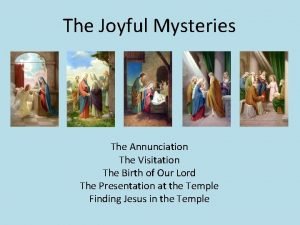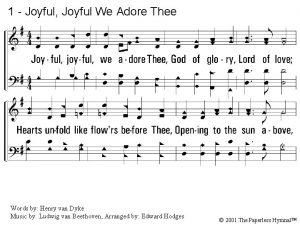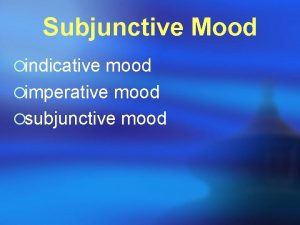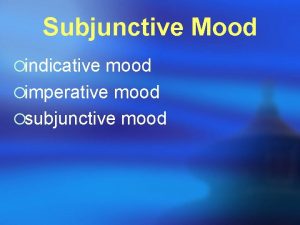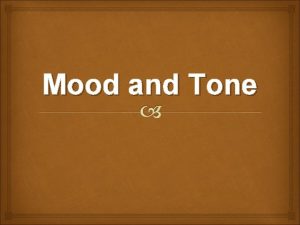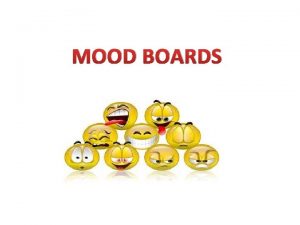Joyful mood is a meritorious deed that cheers


















- Slides: 18

Joyful mood is a meritorious deed that cheers up people around you like the showering of cool spring breeze.

Categorical Data Analysis Chapter 8: Loglinear Models for Contingency Tables (SAS: Chapter 12)

Loglinear Models for Counts • Poisson counts: count ~ Poisson(u) • Qualitative factors: X, Y, … • Saturated Model: As usual, the baseline effects are set as 0 for each term

Independence Model • No interaction effect between X and Y on counts; that is, X and Y are independent As usual, the baseline effects are set as 0 for each term

Interpretation of Parameters • The effect of factor on log(odds) is: – Without XY term: – With XY term:

Associations in 3 -way Tables • Let Y be the response, X be the major factor and Z be nuisance factor • The observed marginal association of X on Y might be simply due to the other factor Z • In general we cannot collapse a 3 -way table and interpret the 2 -way marginal table

Example: Z = Clinic Response Clinic Treatment Success Failure 1 A 18 12 B 12 8 A 2 8 B 8 32 A 20 20 B 20 40 2 Total

Example: Z = Sex Partial table Response Sex Treatment Died Lived Men Standard 950 50 New 9000 1000 Standard 5000 New 5 95 Standard 5950 5050 New 9005 1095 Women Total Marginal table

Type of Independence of X, Y Conditionally independent with Z Mutually independent with Z Jointly independent with Z Marginally independent

Associations in 3 -way Tables Eg. 2 x 2 x. K tables • Conditional odds ratio • Marginal odds ratio • Marginal independence of X, Y: marginal X-Y odds ratios are all 1 • Conditional independence of X, Y given Z: conditional X-Y odds ratios given Z are all 1

Partial Association (Sec 2. 3) • The associations in partial tables are called “partial” associations between X and Y given Z • They are measured by conditional odds ratios

Associations in 3 -way Tables • We need to condition on all important variables; but it is not practical. • In randomized experiments this (confounding) problem is less likely to happen. • To study whether an association exists between a primary factor and the response variable AFTER controlling for other possibly confounding variables, such as – Different medical centers – Severity of Condition – Age

Loglinear Models for 3 -way Tables • Saturated (also full) model:

Interpreting Model parameters • X: effect of X on (expected) counts • XY: the partial association between X and Y given Z • XYZ: significant XY depends on Z insignificant XY does not depend on Z

Interpreting Models Loglinear Model Symbol (X, Y, Z) (Y, XZ) (XY, XZ) (YZ, XZ) (XY, YZ, XZ) (XYZ) Interpretation

Inference for Loglinear Models • Goodness-of-fit tests • Residuals • Tests for partial associations • Confidence intervals for odds ratios

The Loglinear-Logit Connection • Using logit models to interpret loglinear models • Correspondence between loglinear and logit models Loglinear symbol Logit symbol (Y, XZ) (--) (XY, XZ) (XZ, YZ) (XY, YZ, XZ) (X+Z) (XYZ) (X*Z)

Connection with Logit Models • The loglinear model which corresponds to a logit model is the one with the most general interaction among explanatory variables from the logit model. It has the same association and interaction structure relating the explanatory variables to the response.
 Meritorious deed
Meritorious deed Joyful joyful
Joyful joyful Meritorious promotion usmc requirements
Meritorious promotion usmc requirements Meritorious pronunciation
Meritorious pronunciation The white team cheers for the blue team, just like
The white team cheers for the blue team, just like Jeopardy timer
Jeopardy timer Tôn thất thuyết là ai
Tôn thất thuyết là ai Phân độ lown ngoại tâm thu
Phân độ lown ngoại tâm thu Walmart thất bại ở nhật
Walmart thất bại ở nhật Sau thất bại ở hồ điển triệt
Sau thất bại ở hồ điển triệt Gây tê cơ vuông thắt lưng
Gây tê cơ vuông thắt lưng Block xoang nhĩ độ 2
Block xoang nhĩ độ 2 Tìm vết của mặt phẳng
Tìm vết của mặt phẳng Thể thơ truyền thống
Thể thơ truyền thống Con hãy đưa tay khi thấy người vấp ngã
Con hãy đưa tay khi thấy người vấp ngã Thơ thất ngôn tứ tuyệt đường luật
Thơ thất ngôn tứ tuyệt đường luật Joyful mysteries
Joyful mysteries Clap your hands all ye peoples make a joyful noise
Clap your hands all ye peoples make a joyful noise Joyful mysteries
Joyful mysteries
















